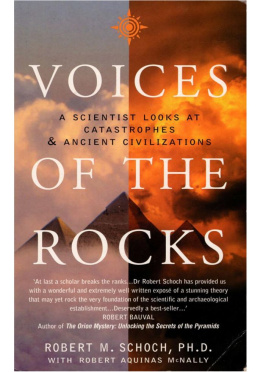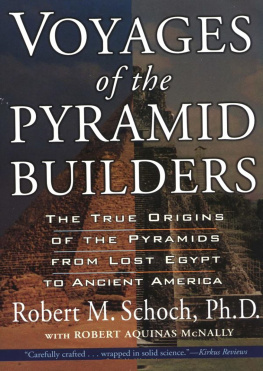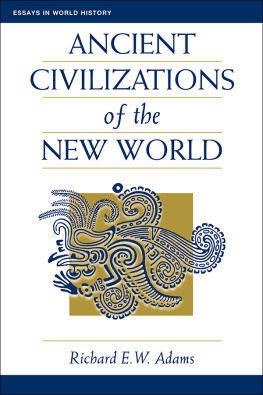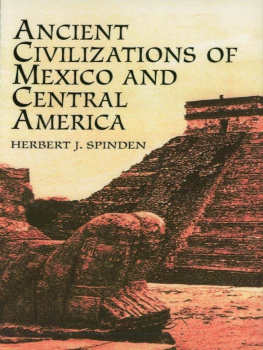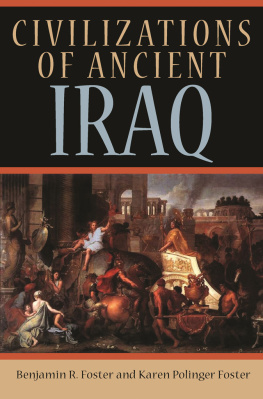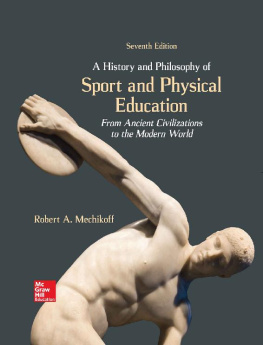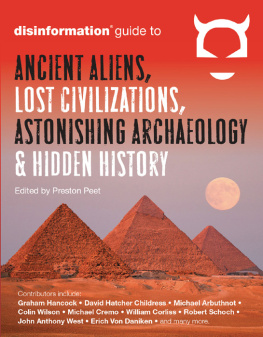Robert M. Schoch - Voices of the Rocks: A Scientist Looks at Catastrophes and Ancient Civilizations
Here you can read online Robert M. Schoch - Voices of the Rocks: A Scientist Looks at Catastrophes and Ancient Civilizations full text of the book (entire story) in english for free. Download pdf and epub, get meaning, cover and reviews about this ebook. year: 1999, publisher: Harmony, genre: History. Description of the work, (preface) as well as reviews are available. Best literature library LitArk.com created for fans of good reading and offers a wide selection of genres:
Romance novel
Science fiction
Adventure
Detective
Science
History
Home and family
Prose
Art
Politics
Computer
Non-fiction
Religion
Business
Children
Humor
Choose a favorite category and find really read worthwhile books. Enjoy immersion in the world of imagination, feel the emotions of the characters or learn something new for yourself, make an fascinating discovery.
- Book:Voices of the Rocks: A Scientist Looks at Catastrophes and Ancient Civilizations
- Author:
- Publisher:Harmony
- Genre:
- Year:1999
- Rating:5 / 5
- Favourites:Add to favourites
- Your mark:
- 100
- 1
- 2
- 3
- 4
- 5
Voices of the Rocks: A Scientist Looks at Catastrophes and Ancient Civilizations: summary, description and annotation
We offer to read an annotation, description, summary or preface (depends on what the author of the book "Voices of the Rocks: A Scientist Looks at Catastrophes and Ancient Civilizations" wrote himself). If you haven't found the necessary information about the book — write in the comments, we will try to find it.
Voices of the Rocks: A Scientist Looks at Catastrophes and Ancient Civilizations — read online for free the complete book (whole text) full work
Below is the text of the book, divided by pages. System saving the place of the last page read, allows you to conveniently read the book "Voices of the Rocks: A Scientist Looks at Catastrophes and Ancient Civilizations" online for free, without having to search again every time where you left off. Put a bookmark, and you can go to the page where you finished reading at any time.
Font size:
Interval:
Bookmark:



MANY PEOPLE HAVE INFLUENCED AND ENCOURAGED ME OVER THE YEARS. I was fortunate to attend George Washington University (Washington, D.C.) as an undergraduate student and Yale University as a graduate student; at both of these institutions I was exposed to many fine faculty members, staff, and students who helped shape my thinking and interests. Since 1984 I have been a full-time faculty member at the College of General Studies, Boston University. The administration, faculty, staff, and students at the College have always been supportive of my studies, and I continually find the interdisciplinary interactions with my colleagues there refreshing and exhilarating. Dr. Brendan Gilbane, Dean of the College, has always been encouraging toward my endeavors, lending advice and support, as did the late Dr. Charles P. Fogg, former chairman of the Division of Science at the College of General Studies.
My research concerning the age of the Great Sphinx would not have been possible without the help and cooperation of many individuals and organizations. In particular, I thank Drs. Mohamed I. Bakr, Ali Hassan, Zahi Hawass, Elsayed Hegazy, and Abdul-Fattah El-Sabbahy (all of the former Egyptian Antiquities Organization) for permission to pursue geological and geophysical studies on the Giza Plateau. Ahmed Nour-el-Din was extremely helpful during my March 1993 trip to Egypt, as was Nehad Gamal. 1 thank Drs. Gaber Barakat, L. Abdel-Khalek, M. M. El Aref, and Eglal Refai (all of the Faculty of Science, Cairo Universify) for their interest, advice, and help. Dr. Thomas L. Dobecki (formerly of McBride-Ratcliff and Associates, Houston) provided invaluable assistance with the geophysical studies on the Giza Plateau. The staff at Geosignal, Inc. (Houston), contributed their talents in processing the high-resolution seismic reflection data. Dr. Frank Ward of the American Embassy in Cairo also helped me immensely, giving freely of his time and expertise. Dr. Hanny M. El Zeini provided needed encouragement early in the Sphinx project. I also extend thanks to Drs. Lambert T. Dolphin (formerly of Stanford Research Institute) and Mark Lehner (University of Chicago) for helpful discussions, especially during the early stages of this project, and to Drs. James J. Hurtak and Robert G. McKinney for helpful advice and discussion more generally.
Dr. Robert Eddy (formerly of the College of Basic Studies, renamed the College of General Studies in September 1992, of Boston University) first introduced me to John Anthony West, and it was as a result of discussions with West that I became interested in the problem of the age of the Sphinx. Thus, West is responsible for initiating this aspect of my research, and he and Boris Said deserve credit for their hard work relative to the logistics of the Sphinx project. In particular, Boris undertook most of the hammer-slinging during the April 1991 seismic studies (I will ignore, for the moment, his suggestion that the Sphinx is nothing but a fancy hood ornament on a giant sports car buried under the sand). Here I express my thanks to both West and Said for their continuing help and encouragement.
It was through the generosity of Yasuo Watanabe (Japan Medical Dynamic Marketing [MDM], Inc., Tokyo) that I was able to visit Yona- guni Island and explore the Yonaguni Monument on 23-24 September 1997. I sincerely thank him for his hospitality and patronage. Graham Hancock was instrumental in arranging the trip to Yonaguni, and he and his wife, Santha Faiia, joined me there to dive on the monument. John Anthony West accompanied me to Yonaguni, participated in the scuba diving, and engaged me in many deep discussions (as he always does) concerning the Yonaguni Monument and related matters. Shun Daichi (Tokyo correspondent of New Perspectives Quarterly) also joined us in diving, and provided me with various reference materials on the Yonaguni Monument and help in translating. Kihachiro Ar a take, who actually discovered the Yonaguni Monument, was our guide for the dives, and dive masters Hiroshi-Kubota and Yoshimi Matsumura provided us with invaluable assistance, as did Megumi Kondo (MDM), Akiko Ito (MDM), Ken Yamada (Ortho Development Corporation, Utah), Dale Kimsey (Ortho), and Steve Hubbard (Ortho). Dr. Michael Pill and Linda Moulton Howe provided me with copies of references from the Japanese Super Mystery Magazine Mu.
I returned to Japan in late July and early August 1998 to further study the Yonaguni Monument and related structures as a member of the Team Atlantis multidisciplinary underwater research team and documentary film project. I thank Michael Arbuthnot for organizing this effort and inviting me to participate. Boris Said, producer for Team Atlantis, once again was immensely helpful in making sure that everything worked out. The project would have been impossible without the assistance of Iris DeMauro, who gave freely of her time and energy throughout the expedition and allowed us to stay at her family's beach house in Okinawa during the latter half of the trip. Matthew Sapero, webmaster for the Internet site www.teamatlantis.com, engaged me in much stimulating discussion during the trip and helped me with all things related to computers (including the sending and receiving of E-mail and files so that I could continue working on this book even while in Japan). Dr. J. J. Hurtak and Dr. John T. Dorwin also participated in this trip; sharing freely of their knowledge and opinions, they gave me much food for thought. Also in Japan with the Team Adantis 1998 expedition were Janet Arbuthnot, Christopher DeFelice, Sarah Kingston (who provided invaluable assistance to me underwater), Peter McDougall, Vince Pace, D. J. Roller, and Sandy Wright. I thank them all for their participation. In Japan we were assisted by many people; in particular I would like to single out Kihachiro Aratake (again, as in 1997, he was invaluable in arranging the diving in Yonaguni), Atsushi Mori (who helped us in many ways), and Chie Mikami of Ryukyu Asahi Broadcasting Corporation (who helped us locate an underwater site in the Chatan area of Okinawa). Finally, I extend heartfelt thanks to Dr. Masaaki Kimura for his hospitality. Dr. Kimura met with us numerous times during our stay and explained in detail his ideas regarding the Yonaguni Monument and similar structures. I greatly appreciate his years of research.
Innumerable other persons have taken an interest in my research more generally, and have helped out in various ways. Unfortunately, it would be virtually impossible to list everyone I have had contact with concerning my research, but I would like to acknowledge the help, support, and interest of a few more people in particular, including: Alessandro Abdo, Sean Adair, Alicia Alexander, Bodhi Annan, Millard Baublitz Jr., Robbin Beauchamp (who carpooled with me to Boston University during the height of the Sphinx controversy, and heard more than she probably cared to about the Sphinx), Paul Bierman, David P. Billington Jr., Peter E. Busher, Sita Chaney, John Cheshire, Molly Cheshire, Rita Corriel, Bill and Carol Cote, Barbara Crane, Anh Crutcher, Nelson Dale, Caroline Davies, William E. Davis, Kate Dickie, Lloyd Dickie,
Frank Domingo, Michael Eldredge, Dennis C. Forbes, Tim Friend, Jean A. Garrison, Alison and Gilbert Gjersvik, Linda Goldstein, Diane Graszik, Jim Green, Terence Guardino, Eileen P. Guriy, Foxy Gwyne, Samuel Hammer, Khadija S. Hammond, Marta J. Hersek, John Hipsley, Sandy and Chuck Houghton, Natalia Ignatieff, Nicholas Ignatieff, Jorjana Kellaway, Michael G. Kort, Devendra Lal, Mary Lomando, Nancy Long, Michael G. Mahon, Michele Matthews, John E. Miller, Mohammed Nazmy, Richard W. Noone (who pushed me hard to write this book and supplied me with various useful leads and reference materials), T. C. Onstott, Robert Oresick, Matthew A. Parfitt, Marshall Payn, Cheryl Poppaw, Andris and Margaret Priede, Peyton E. Richter, Paul William Roberts, Joseph Schor, Tamer Shawsky, Diana Shields, C. Simonds, Lydia Smithers, David Solomon, Sally Sommers Smith, Richard Speir, Samuel Stern, Gigi Van Deckter, Robert M. Watts, Celesta West, Joanne Wright, and Stan Zippan. I apologize to anyone I have inadvertently missed.
Font size:
Interval:
Bookmark:
Similar books «Voices of the Rocks: A Scientist Looks at Catastrophes and Ancient Civilizations»
Look at similar books to Voices of the Rocks: A Scientist Looks at Catastrophes and Ancient Civilizations. We have selected literature similar in name and meaning in the hope of providing readers with more options to find new, interesting, not yet read works.
Discussion, reviews of the book Voices of the Rocks: A Scientist Looks at Catastrophes and Ancient Civilizations and just readers' own opinions. Leave your comments, write what you think about the work, its meaning or the main characters. Specify what exactly you liked and what you didn't like, and why you think so.

